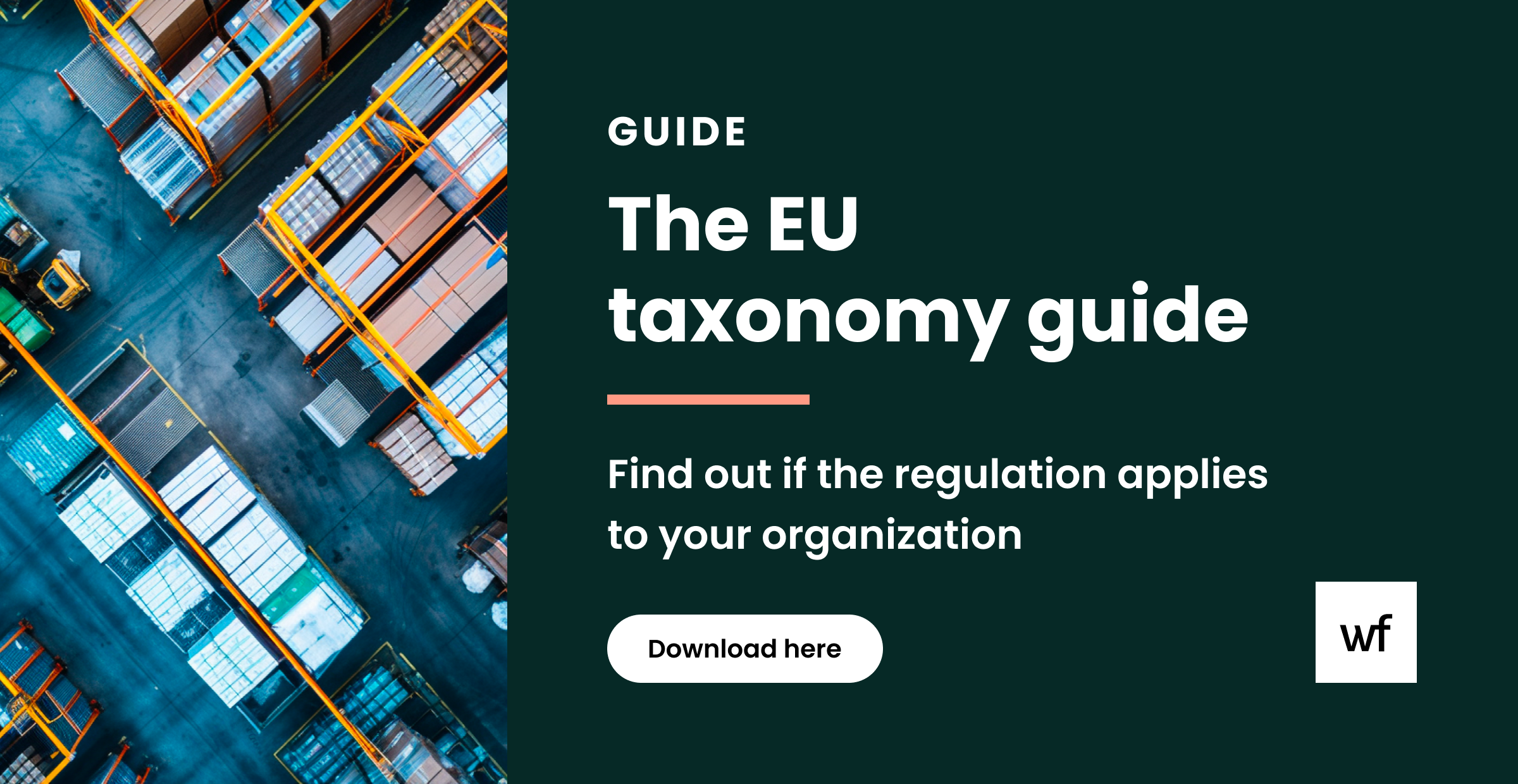5 financial regulations that will affect your sustainability reporting

Once, corporate sustainability reports and environmental, social, and governance (ESG) disclosures only had to meet whatever standards the company making them chose to meet. Now companies and financial firms need to ensure their sustainability reporting frameworks are in line with government regulations. Some regulations are already in place, but most have yet to be fully implemented and enforced. A few are even still in development and haven’t been officially released. Currently, the European Union is really the only one with requirements for ESG disclosures to investors and the public. But other governments will likely model their reporting regulations on the EU’s, since many, like the United States, are expected to follow suit over the next few years — some of which are already in place and some are on the way.
So here are 5 current and future regulations that will likely require updating your reporting framework or switching to new climate frameworks in the near future, along with key dates to watch out for.
1. EU’s sustainable finance disclosure regulation (SFDR)
Passed in the spring of 2019, Sustainable Finance Disclosure Regulation (SFDR) is a cornerstone in the regulation of sustainable finance. It aims to prevent greenwashing by creating transparency around sustainability within the financial market. It requires Financial Market Participants (FMPs) operating within the EU — both on a firm and product level — to disclose information on their sustainability practices and sustainability indicators. Presenting such information will force a full review of any firm’s business and undoubtedly lead to new policy decisions, applying to all FMPs, not just those offering financial products with a sustainability or ESG focus.
SFDR key dates:
- March 10th, 2021: When most of the SFDR’s substantive framework requirements and general principles must begin being applied. It’s the earliest date to begin the first reference period for reporting.
- June 30, 2021: The final date that FMPs with more than 500 employees must start considering principal adverse impacts and collecting relevant data for the first reference period.
- January 1st, 2022: The first day of the second reference period and when periodic reporting obligations begin to apply.
- December 30th, 2022: When additional periodic reporting obligations begin to apply.
- June 30, 2022: The last date that FMPs can report for the first time their performance on various ESG indicators, including “details of the assessment of principal adverse sustainability impacts” from the first reference period.
If you would like to get to know more about how to get ready for the SFDR with Worldfavor, download our guide here.
2. EU’s amendment to non-financial reporting directive (NFRD)
One of the major challenges caused by SFDR has been that many FMPs, like investment fund managers, find themselves required to make disclosures before the companies they invest in are legally obligated to provide detailed sustainability information. What information companies are supposed to disclose that isn’t financial is regulated by the EU’s Non-Financial Reporting Directive (NFRD). It currently has no provisions related to sustainability or ESG. But an initiative for an amendment, which is legislative change to the NFRD, is in the works. The update will legally require large companies (those with more than 500 employees) to “disclose non-financial information on their social and environmental impact”. When it is added, the new requirements will likely create a rippling of updates in reporting frameworks, through supply chains and up investment ladders.
NFDR key dates:
- April 21st, 2021: When the EU’s Financial Services Commissioner is reported to announce its plans for adding ESG requirements to NFRD.
3. EU Taxonomy regulation
The EU Taxonomy is a regulatory classification system, which defines whether certain economic activities are environmentally sustainable. It provides FMPs and large company’s a toolkit for assessing their sustainability, as well as how to promote and market themselves as such, and is thus a big part of many sustainability reporting frameworks. The EU Taxonomy lists six key objectives for performance thresholds: Climate change mitigation; Climate change adaptation; Sustainable use and protection of water and marine resources; Transition to a circular economy; Pollution prevention and control; Protection and restoration of biodiversity and ecosystems.
EU Taxonomy key dates:
- January 1st, 2022: Financial institutions and large companies must start reporting on Taxonomy-eligibility for the two climate objectives.
- January 1st, 2023: Large companies must report on Taxonomy Alignment.
- 2023: Technical screening criteria for the remaining four environmental objectives start to apply.
- January 1st, 2024: Financial institutions and large companies must report on Taxonomy alignment.
- 2024: Full EU Taxonomy disclosure on all six environmental objectives.
Download the Worldfavor EU Taxonomy guide to find out if the regulation applies to your organization.
4. EU’s Draft Delegated Acts for investment managers and firms
One major upcoming piece of the European Commission’s Sustainable Finance Action Plan is a group of draft measures to update regulations for specific kinds of investment firms to include reporting frameworks for public and investor-facing ESG disclosures. The types of firms and managers affected are:
- Undertakings for Collective Investment in Transferable Securities (UCITS)
- Alternative Investment Funds (AIF)
- Markets in Financial Instruments Directive (MiFID) Firms
Draft Delegated Acts key dates:
Q3 or Q4 2021: Although the acts are still in draft form, they are expected to come into effect sometime in the last half of 2021.
5. EU Ecolabel for financial products
First established in 1992, the EU Ecolabel is a mark of environmental excellence that is given only to products and services that meet strict standards of sustainability and specifically contribute to a circular economy. There are EU EcolabeIs for everything from cleaning products and electronic equipment to hotels and campsites; each category with its own rigorous criteria to earn the label. And an EU Ecolabel for financial products, with its own reporting framework and minimum requirements, is currently in the works. The EU’s Joint Research Centre (JRC) published its first preliminary report on EU Ecolabel criteria for financial products in March of 2019 and is expected to deliver its final recommendations for the criteria in 2021.
EU Ecolabel financial products key dates:
Q4 2021: While still an ongoing project at JCR, the final criteria for financial products to receive the EU Ecolabel is expected to be adopted by the European Commission in the last quarter of 2021.
Keeping up with lawmakers to save the climate
We’re seeing constant changes in laws and regulations as a response to the climate crisis. That means there will not only be more requirements on what needs to be reported from more government bodies, national and local, but also changes and updates to the ones that already exist. For companies it means keeping up with new requirements and maybe stepping up their sustainability game with higher transparency and a sustainability management process.
Keep up with news and updates within ESG and corporate sustainability by subscribing to Worldfavor’s Sustainability Blog.
Related blog posts you might like:






%20as%20the%20deadline%20approaches.%20Learn%20about%20compliance%20requirements%2c%20potential%20delays%2c%20and%20key%20updates..png)

